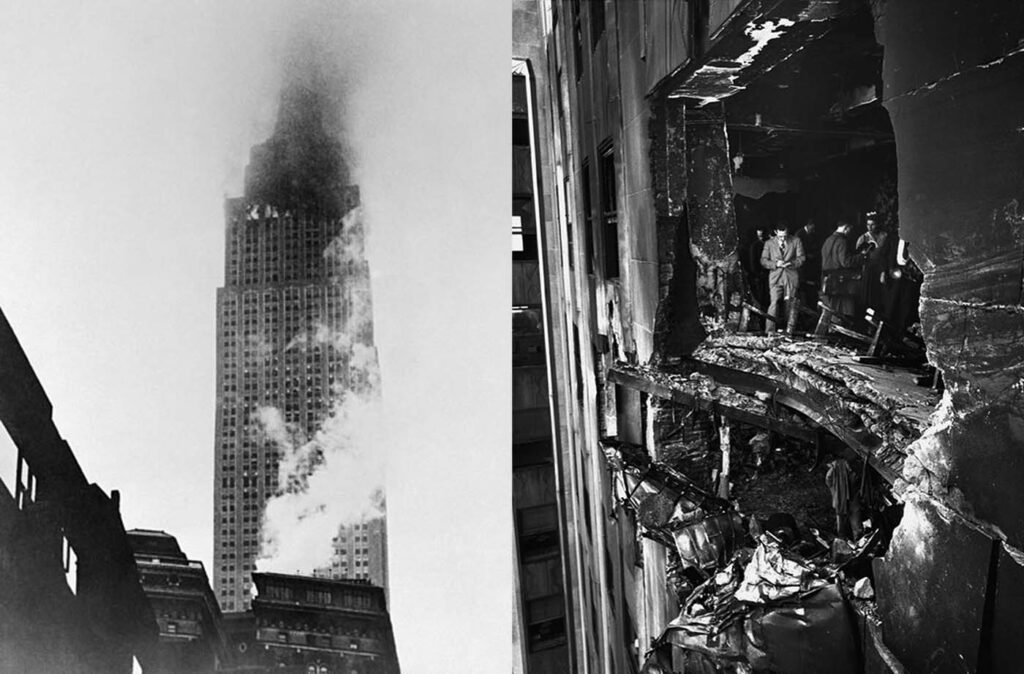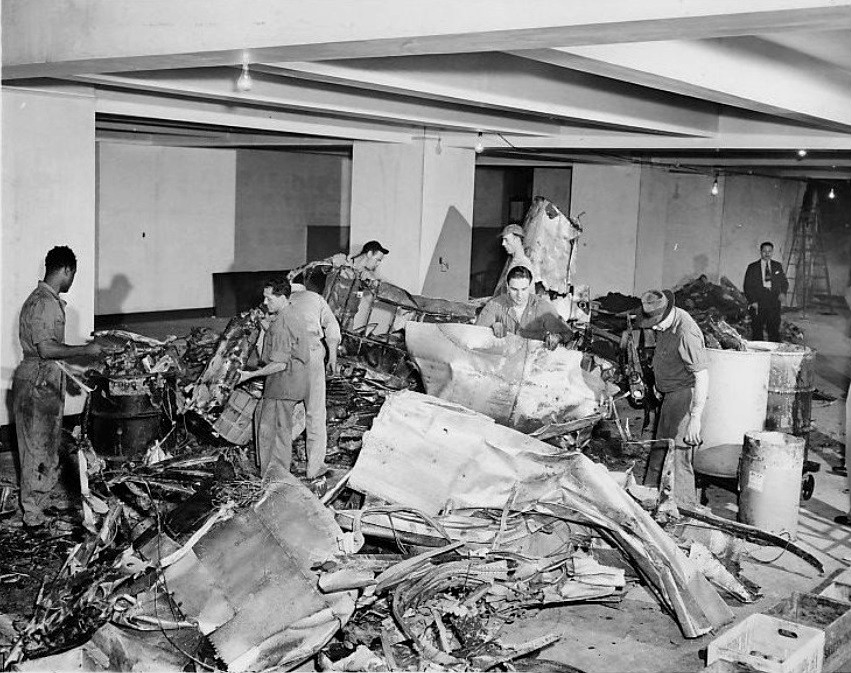Last updated on November 28th, 2023 at 05:30 pm
The Empire State Building has long been the pinnacle of the New York City skyline. And like the rest of the city, it has a deep, fascinating history – one that many have never heard of.
Hidden within its towering facade lies a remarkable tale. It is one of both tragedy and resilience that reverberated through the city’s history.
Conjure an image of the dense urban jungle, a dense fog slowly enveloping the city. This was the scene on that fateful day of July 28, 1945.
In a stunning turn of events, a B-25 bomber was off course and flying at a perilously low altitude above the city. Without warning, the plane hit the north side of the iconic building.
What led to such a catastrophe? How did it unfold and how did emergency responders handle the ensuing chaos and devastation of the Empire State Building plane crash?

July 28, 1945
On that fateful day of July 28, 1945, Lieutenant Colonel William Franklin Smith Jr. took command of a B-25 Mitchell bomber. The route was for a routine personnel transport mission from Bedford Army Air Field in Massachusetts to Newark Metropolitan Airport in New Jersey.
It was a day like any other. The B-25 bomber soared through the sky, carrying servicemen returning home from their duties as World War II neared its end.
Capt. Smith, an experienced pilot who had braved perilous missions in Europe, navigated the aircraft with confidence. However, as Smith approached the New York area, the weather took a turn for the worse.
The city was cloaked in dense fog, significantly reducing visibility. Seeking to land at LaGuardia Airport, Smith reached out to the tower for clearance. The tower, however, informed him of zero visibility and recommended against landing.
Smith, perhaps underestimating the severity of the conditions, decided to press on. Ignoring the tower’s warning, he continued his descent.
As the bomber ventured further into the fog, the situation became increasingly precarious. Smith found himself disoriented. In a moment of confusion, he made a critical error.
Instead of turning left after passing the Chrysler Building, he turned right. In that instant, the path of the B-25 bomber carried it into the heart of midtown Manhattan.
The clouds momentarily broke, revealing a startling truth to Smith: he was flying perilously close to the towering skyscrapers, including the Empire State Building.
Then The Clouds Parted
At 9:40 a.m. on that ill-fated Saturday, the bomber was hurtling through the fog at a staggering speed of 200 miles per hour. It then collided with the north side of the Empire State Building.
They narrowly avoided a collision with the Art Deco Chrysler Building and the extensive Grand Central Office Building, which spanned from 42nd to 56th Streets between Madison and Lexington Avenues. Smith then attempted to ascend and change course. However, his actions came too late.
The impact carved a massive 18-by-20-foot hole between the 78th and 80th floors. The plane penetrated the offices of the War Relief Services and the National Catholic Welfare Council.
The devastating crash sent shockwaves through the Empire State Building. It dislodged one of the bomber’s engines, which careened through the south side and plummeted to the street below. This caused a fire that engulfed a penthouse art studio in a nearby building.
Meanwhile, the other engine and part of the landing gear fell and plunged down an elevator shaft. As it tore down through the elevator shaft, it snapped a cable holding up an occupied elevator car. Luckily, the falling elevator car was saved by the elevator system’s emergency hydraulics.
All those on the streets below must have simultaneously looked up in horror as they came to realize what was happening.
Higher up, an estimated 50 or so individuals were taking in panoramic views of New York City from the 86th-floor observation deck. One can only imagine how they felt watching the bomber peel out of the clouds right underneath them.
Tragically, the collision claimed the lives of Colonel Smith, Staff Sergeant Christopher Domitrovich, and Navy Aviation Machinist’s Mate Albert Perna. It also killed eleven civilians who were working inside the Empire State Building.
Among the survivors were individuals like Therese Fortier Willig, who worked on the 79th floor. And Gloria Pall, who was on the 56th floor.
In the aftermath, Willig vividly recalled the horrifying scene of flames engulfing the office space while they sought refuge in an untouched room. All the while knowing that others were not going to be as fortunate.
Pall was thrown across the room by the force of the impact. She was gripped by sheer terror as the building swayed and people around her screamed in confusion.
Amid the chaos and panic, an individual by the name of Paul Dearing made the desperate, unfortunate choice to jump. The tragic event trapped hundreds of office workers within the blazing Empire State Building. This led to a scene of unimaginable horror and uncertainty.

Aftermath: Chaos, Tragedy, and Recovery
In the aftermath of the tragic Empire State Building plane crash, the devastating accident claimed the lives of fourteen individuals. This included three crewmen and eleven people who were inside the building.
An additional estimated twenty-four individuals suffered injuries, ranging from minor to severe. Despite the tragic loss of life and the estimated $1 million in damages (equivalent to almost $17 million in 2023), the structural integrity of the iconic building remained intact.
Remarkably, less than 48 hours later, the Empire State Building resumed operations on many floors. This proved a testament to the resilience, hard work, and determination of those involved in the recovery efforts.
Particularly inspiring were the efforts of the New York Fire Department who quickly extinguished the blaze in the direct aftermath.
They assisted in rescuing many of the individuals still trapped in the building, including a woman trapped in the elevator car. They did this by cutting into the elevator shaft’s concrete wall to rescue her.
Firefighters rescued one survivor named Betty Lou Oliver and placed her in an elevator with cables damaged by the fire, resulting in her plunging 75 floors. Miraculously, she survived.
The crash catalyzed change. It prompted the passage of the Federal Tort Claims Act, which had long been pending. This act, signed into law by President Harry S. Truman in August 1946, even included retroactive provisions that allowed individuals to sue the government for the accident.
Despite the Empire State Building plane crash, the iconic landmark remained an enduring symbol of strength and resilience. It stands as the tallest building in the world and continues to inspire awe and wonder for tourists and locals alike.
References
“The Day When a B-25 Mitchell Bomber Crashed into the Empire State Building in New York City, 1945.” Rare Historical Photos, October 24, 2022. https://rarehistoricalphotos.com/empire-state-building-plane-crash/.
“Remembering the 1945 Empire State Building Plane Crash.” New York Daily News, July 21, 2022. https://www.nydailynews.com/news/remembering-1945-empire-state-building-plane-crash-gallery-1.2729506.
Richman, Joe. “The Day a Bomber Hit the Empire State Building.” NPR, July 28, 2008. https://www.npr.org/2008/07/28/92987873/the-day-a-bomber-hit-the-empire-state-building.

